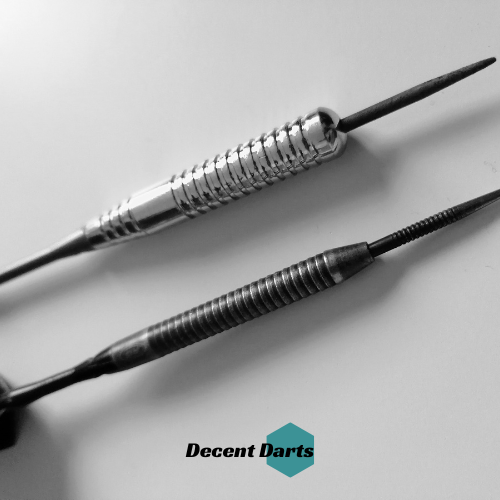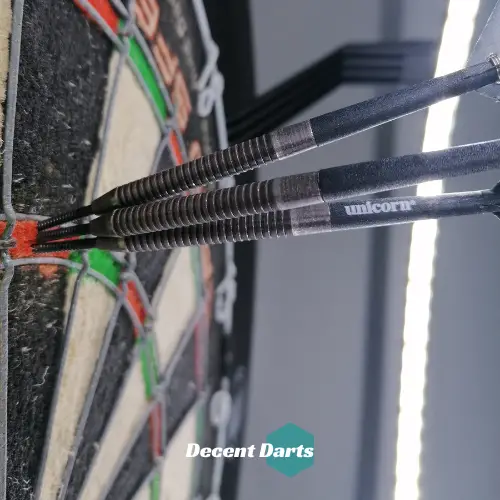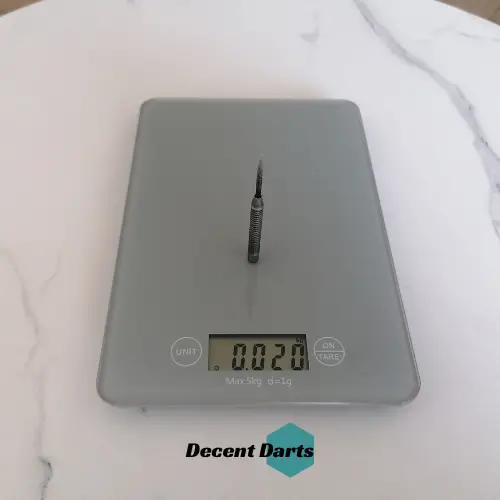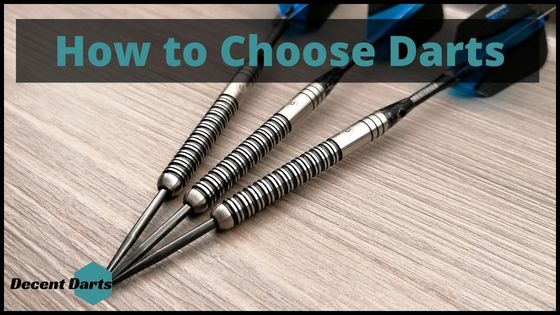If you’ve just started watching/playing darts then one of the first things you’ll want to do is pick up your own set.
For most beginner players, this can be both an exciting but confusing process. There are currently thousands of dart designs with darts coming in a range of weights, sizes, shapes, and designs.
Looking at some common distributors in the UK, I think there are at least 2,000+ dart models currently available to buy from all brands combined. Darts Corner alone have 1,334 steel tip options available on their site.
With so much choice, it can be overwhelming to know where to start and how to choose darts if you’ve never bought any before.
Therefore, in this article, I’m going to cover a very important topic – how to choose darts.
I’ll explain exactly what you need to look for in a set of darts so that by the end of the article, you’ll know how to choose a set for your individual preferences and requirements.
How to Choose Darts (7 Steps)
My very first set of darts was a set by Harrows (Eric Bristow set) which were made of nickel silver and had a rounded barrel near the dart point making them quite front heavy.
I still have the set now and for comparison, take a look at my first set of darts compared to my current set of Red Dragon Razor Edge.

That’s quite a difference in design!
The reason for this is that I started to play competitive darts and the wide barrel and overall long length of the dart meant that I was restricting my scoring potential.
I upgraded to a set of tungsten darts with a rougher grip (knurling on both the dart barrel and dart point), the darts were the same weight but significantly thinner due to the density of the material.
Since then my scoring and finishing have improved noticeably.
My throw was the exact same so the darts didn’t make me any better but they did suit my game more.
The reason I’m writing this article is to share with any beginners the process for how to choose darts – especially your first set – and give the tips and knowledge that I didn’t have when choosing my own first set.
There are 7 steps to consider when choosing your own set of darts:
- Choose a Barrel Material
- Choose a Barrel Profile
- Choose a Barrel Weight
- Choose a Barrel Weight Distribution
- Choose a Grip
- Decide on your Price Range
- Decide on Accessories
Step 1: Choose a Barrel Material
One of the most important decisions when first buying a set of darts is the barrel material.
Darts barrels come primarily in three different materials:
- Brass
- Nickel silver
- Tungsten
You can get a blend of these materials and when it comes to the quality of the dart, I’ve ranked the above in the order of perceived quality.
Brass darts are the cheapest option and the most generic. When you buy a starter dartboard, the free set(s) of darts that come with it will typically be brass.
If you get a free set of brass darts with a dartboard, feel free to use them as your first set but brass would not be my recommendation when choosing your own.
Brass is not a dense material so in order to get heavier darts the size of a brass barrel will need to increase significantly.
Nickel silver is the next step up in terms of barrel material.
Nickel silver is slightly more dense than brass and you’ll find nickel silver darts can have a much better grip as manufacturers can use more advanced techniques to create darts knurling*.
*Knurling on a dart is a machine etched design that cuts ‘grooves’ into the barrel of the dart in order to improve grip.
Similar to brass darts though, it’s still quite difficult to get a slim dart with your desired weight due to the material density.
Finally, we have tungsten darts.
It’s widely considered or accepted that tungsten darts are better and are considered to be the best quality. Tungsten darts are used by most professional players these days.
The main reason being that tungsten is a dense material and darts can therefore be made much slimmer regardless of the desired weight.
This is beneficial because a slimmer dart will take up less space inside a treble meaning there is more room for additional darts.
The more space you have to aim at, the better the chance (both statistically and theoretically) you have of scoring more.
Related – Tungsten vs brass vs nickel silver darts
Brass Darts Pros and Cons
Pros:
- Cheap
- Often come with dartboard sets
Cons:
- Lower-quality material
- Less dense meaning heavier darts are bigger
- Generic design
Nickel Silver Darts Pros and Cons
Pros
- Affordable
- Durable
Cons
- Not the highest quality
Tungsten Darts Pros and Cons
Pros
- Durable
- High density
- Slimmer dart making it easier to group darts
- Used by professionals
- Look good
Cons
- Can be expensive depending on the tungsten %
Step 2: Choose a Barrel Profile
Once you know what material you want your dart to be, you’ll next need to consider the barrel profile or design.
This is important because the way that you hold a dart will dictate what type of barrel you choose. Personally, I prefer a straight and slim barrel because I can group my darts so much better…

There is a range of barrel designs that will suit different throwing styles or preferences, some of these include:
Straight
The generic darts barrel is a straight barrel. This means that the weight of the dart is equally distributed throughout the barrel.
Bomb
A bomb barrel design is thicker at the front of the dart and slimmer to the rear. These can be easier to grip due to the wider surface area at the front of the dart but they can limit your scoring potential due to the larger size.
Scalloped
A scalloped dart barrel can be straight, bomb, or torpedo by design but the key differentiator is that there is an indent in the middle of the barrel.
This is for better thumb placement for those that grip the dart primarily using the thumb.
A scalloped barrel doesn’t offer a distinct advantage over other barrels, the design looks good but it’s mainly to cater to a specific throwing style (thumb grip)
Tapered
A tapered barrel is thicker towards the rear and much slimmer towards the front. This is designed to offer a comfortable grip whilst also leaving plenty of space to group your darts in a treble bed.
Torpedo
A torpedo barrel is similar to a bomb barrel in that it’s front weighted and thicker at the front.
This type of barrel is ideal for players who struggle to generate force when they throw the dart and the front-loaded weight ensures the dart will hit the board and stay in it.
Specialized
A specialized barrel will often be custom-made.
These kinds of darts are often endorsed by professional players and the design will be based on their own dart sets.
You’ll see specialized darts with different grip designs and barrel styles.
For most beginner players, it’s not recommended to opt for a specialized dart as the grip and the way it flies will not be as natural as a standard barrel for example.
Step 3: Choose a Preferred Barrel Weight
Browse any darts website and you’ll see one of the drop-down categories is weight, take a closer look and you’ll see the dart weights can vary between 10g – 48g.
That is a significant difference in weight!
Finding the weight that best suits your throw can be difficult, it could come down to individual strength, how you hold a dart, how far you drawback your throwing arm, how you release the dart… The list goes on!
As there is such a list of factors that influence weight, the best process is to test some darts first and see what works best.
If you have any friends or family that play darts you could test their darts, if you live near a darts shop you could test some different weights there and as a last resort, you could order some sets of cheap darts to test the different weights.
If these options are not ideal, it’s worth knowing that an average dart weight most commonly used is between 21g – 24g.
Red Dragon Darts have researched this using their own sales figures to find out what the most common or popular dart weights are.
Following their research, the most common dart weights are:
1) 22g
2) 24g
3) 26g
By buying a dart within this range you can use it as a good baseline.
Beginners should get a slightly heavier weight to compensate for a lack of technique and release power so opt for the 24g – 26g range.
More experienced players can test out lighter darts once you have technique locked in. I currently use 20g darts which feels like a sweet spot after 15+ years of playing.

I’d recommend going on the lower end in terms of weight because it’s easier to add weight to darts to make them heavier than it is to try to drop some weight.
Step 4: Choose a Barrel Weight Distribution
Linked with barrel weight is barrel weight distribution.
We covered this briefly before with different barrel designs but the weight distribution should also be a key consideration.
There are three general weight distributions in darts which are:
- Balanced weight
- Front-loaded weight
- Rear-loaded weight
Most players (especially beginners) will opt for a balanced weight with their dart as this naturally feels more comfortable for most people.
Depending on how you hold a dart the weight distribution will dictate the trajectory of the dart and ultimately, how accurate you are.
A front-loaded weight and a rear-loaded weight will be better suited to a “front gripper” or a “rear gripper” in darts. These sound like strange terms but it essentially means where you naturally hold a dart.
Step 5: Choose a Dart Grip
A common issue among beginners is learning how to hold and grip a dart.
It sounds simple but when it comes to releasing that dart, your grip will influence how smooth the release is.
If you’re anything like me and get sweaty hands during a game, a dart slipping during release can be a very common thing.
Alternatively, some players struggle with darts that have too much grip as it doesn’t leave their fingers smoothly.
For this reason, darts have a grip rating of 1 – 5 for most manufacturers and this is rated smooth to aggressive.
I personally use a higher-rated grip with etched knurling (I even have knurling on the dart’s point) because I struggle to grip the dart when my hands start to sweat.
If you’re unsure of the level of grip you might need, opt for somewhere in the mid-range as most people will still want some grip on their dart.
Too smooth of a dart and you’ll find you release it too early with less control, too much grip and you will struggle to actually let go of the dart as it ‘sticks’ to your fingers.
Many darts now also have dedicated grip zones with knurling, radial grooves, lateral cuts, scallops and a range of other manufacturing designs.
Again, stick to few common designs as a beginner while you are learning where you like to hold the dart and what sort of feel is right for you.
Step 6: Decide on Your Price Range
I’ve kept this section quite near to the end because darts in general are not overly expensive.
Sure, you can get some expensive sets like Target Darts RVB but in general, a good set of darts can be purchased for $25 – $50 (£15 – £40).
At the higher price ranges, you aren’t getting anything additional to what you’d get in a cheaper price range.
Once you know the material, barrel profile, and desired weight – everything else is aesthetic or has features that only pro players or serious hobby players could even appreciate!
Therefore, don’t focus too much on price.
Darts equipment can be expensive for a full darts set up but for the darts specifically, you can get an amazing set at a relatively inexpensive price.
We’d recommend first checking out our guide on the best tungsten darts. Here we’ve selected some popular darts often used by beginners.
Step 7: Decide on Accessories (Shaft, Flights)
Finally, you’ll want to consider the accessories used.
Both the dart shafts and the dart flights can significantly influence the trajectory and accuracy of the dart – regardless of a player’s experience or skill level.
Dart shafts come in different lengths and materials.
Fortunately, you can get a mixed pack at an affordable price to test the different lengths – short, medium, or long as standard (though shorter or longer sizes are available).
See also:
– How to choose dart shafts
– Best dart shafts
The most cost-effective option is to get nylon or plastic stems to find the length that suits you best. Once you are happy with the length, you’ll want to test out aluminum shafts that are far more durable and long-lasting.
As with shafts, the types of dart flights you use will need to be tested to see what works best for your throw and darts set.
It’s best to start off with a standard flight, this is the generic or basic choice but many professional players happily use a standard flight because of the glide and flatter trajectory it gives a dart throw.
From there, you could then look to test out some of the following dart flight types:
- Slim
- Pear
- Kite
- Lantern
Round-Up
Choosing a dart set should not be a rushed decision. If possible, it’s best to test out a range of options just to get a feel for the type of dart that you might prefer.
The good thing is that darts are not overly expensive and there are generic options to test out before making a decision.
For a general recommendation, a tungsten dart weighing 21g – 26g with a standard dart flight is one of the most standardized combinations you can use.
This will give you a good guideline to test and modify as you practice and learn to perfect your throw.
Now that you know how to choose your first set of dart, check out our guide on some of the highest rated and most popular soft tip darts.

